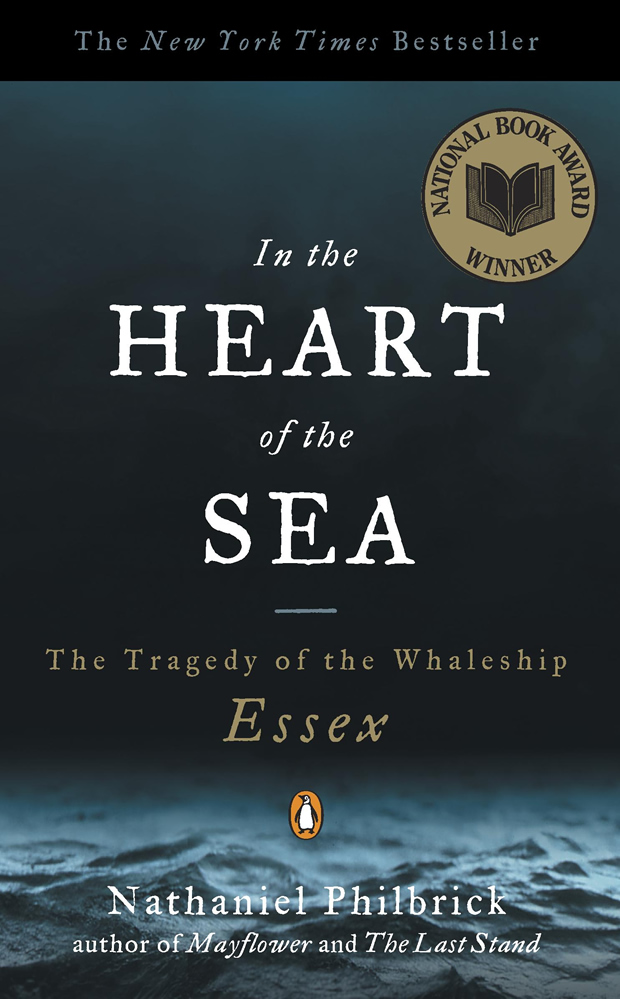In the Heart of the Sea

OVERVIEW
Nathaniel Philbrick’s In the Heart of the Sea is “one of the most chilling books I have ever read,” writes Sebastian Junger, author of The Perfect Storm. Winner of the National Book Award for Nonfiction and on the New York Times bestseller list for 40 weeks, this “spellbinding” (Time) “page turner” (New York Times) tells the true story of the 19th-century whaleship Essex out of Nantucket that got rammed by one of the largest whales anyone had ever seen, the whale that inspired Herman Melville’s Moby-Dick. But the story doesn’t end there. The ship sank, sending the crewmembers adrift for months as they faced storms, starvation, and disease. Award-winning author of more than ten books, Philbrick “has created an eerie thriller from a centuries old tale… Scrupulously researched and eloquently written, In the Heart of the Sea is a masterpiece of maritime history,” writes the New York Times. “It gets into your bones.”
“Hope was all that stood between them and death.” – from In the Heart of the Sea
INTRODUCTION
“How much of assumed national and personal character comes from the fact that we have never truly known need to the point of having our character tested?” – from In the Heart of the Sea
In 1819, 20 crewmembers set sail on a ship called the Essex to hunt whales. They left the popular whaling island of Nantucket, Massachusetts, and headed for the South Pacific in what was to be a routine voyage. Instead, they found themselves part of one of the most horrifying maritime disasters in American history when an 85-foot angry sperm whale rammed and sunk their vessel. For 90 days, the crew drifted in small boats with no sense of where they were in the vast sea. Facing starvation, disease, brutal weather, and a near loss of hope, they succumbed to drastic measures as they fought to stay alive. Nathaniel Philbrick’s In the Heart of the Sea tells the true story of the crewmembers’ fight for survival, and the circumstances surrounding the disaster that inspired Herman Melville’s novel, Moby-Dick, 30 years later.
Hunting and harvesting 60-ton sperm whales on the vast and vastly uncharted Pacific Ocean was neither easy nor safe, but it was big business in the early to mid-1800s during the Industrial Revolution, Philbrick explains in the opening chapters. At the center of this global enterprise was the island of Nantucket, home to roughly 7,000 people, most of whom were Quakers, or as Melville called them, “Quakers with a vengeance.” Men often stayed home for only a few months at a time, with voyages in between that lasted two to three years. This left the women of the island to manage the business operations and raise the children.
The crew of the Essex that left the harbor that fateful day was led by George Pollard Jr., a 28-year-old, first-time captain. Serving under him was his ambitious 22-year-old first mate, Owen Chase; his second mate, Matthew Joy; a cabin boy, 15-year-old Thomas Nickerson; and three boatsteerers, a steward, and 13 sailors, several of whom were African-American men from Cape Cod who came to Nantucket in search of work. From the start, there was friction between Pollard and his next-in-command. “In just about every situation,” says Philbrick, the captain’s “instincts were correct, but he inevitably allowed himself to be talked out of his convictions by his two mates.... As leadership psychologists will tell you, a leader, particularly in a survival situation, must make decisions firmly and quickly” (Philbrick’s website).
Following a squall that destroyed two of the crew’s whaleboats, the Essex sailed around the southern tip of South America and headed back toward the equator where they encountered— nearly a year and a half after they initially set sail from Nantucket—a huge whale with its head pointed toward the side of the ship. Since no whale had ever been reported to attack a ship, they weren’t alarmed, until the whale shockingly picked up speed and slammed the ship’s port side twice. The crew escaped the wreckage in three tiny boats, each led by one of the officers. They took what provisions they could get, and together set out into the cold, choppy, seemingly infinite waters in the middle of the Pacific Ocean, debating the best way to reach land and safety. “If everything had gone right, they might’ve made it. Everything went wrong,” Philbrick told the NEA. The boats eventually separated and months later, many of the surviving whalesmen found themselves acting in ways they never before thought they could.
“A survival tale peels away the niceties and comforts of civilization. Suddenly, all the technology and education in the world means nothing,” says Philbrick on his website. He found inspiration to write this particular survival story in part during the summer of 1997 when he was sailing with his family to Maine and reading such books as Sebastian Junger’s The Perfect Storm and Jon Krakauer’s Into Thin Air (Paris Review). His research in the years that followed was extensive. “I looked to modern-day scientific studies in an attempt to figure out what the crew was experiencing, not only in terms of their suffering at sea, but also in terms of the interpersonal dynamics of a survival situation,” he says on his website. The keys to understanding the facts of the events were Owen Chase’s account written within months of his rescue, and a journal written by Thomas Nickerson, discovered in 1980, which challenges some of Chase’s statements. “Instead of contradicting Chase, Nickerson adds details that the first mate chose not to reveal,” Philbrick explains.
In December of 1998, Philbrick’s wife stopped by their local library to pick up a copy of an article he’d ordered through Interlibrary Loan. As he explains on his website, “The reference librarian greeted her with a look of concern. ‘Is Nat all right?’ she asked. Somewhat bewildered, my wife assured her that, yes, he wasn’t getting out much these days, but everything was fine. It wasn’t until she was walking back to her car that Melissa looked to see that the article was entitled ‘The Nutritional Value of Cannibalism.’”
“I think all of us wonder while reading a survival tale, what would I have done in this situation?” he asks. “Would I have made it? There’s a part of us that feels our pampered 21st-century existence is a kind of lie, I think. We read these stories to experience vicariously the essential truths of life and, of course, death” (Philbrick’s website).
-
Did you know the story of the Essex before you read In the Heart of the Sea? Were you familiar with the U.S.’s history of whaling? If not, you’d be in good company. Why do you think this piece of American history that was so well known in the 19th century is not as well known today? If you did know the story, how did the book enhance or change your perception of what happened?
-
Philbrick has said that one of his biggest challenges in writing a book based on information gathered from a wide variety of sources is figuring out how to begin. Why do you think he chose this particular opening? What are some other ways he could have begun to tell this story?
-
The island of Nantucket and the surrounding sea are described in evocative detail. Is it a familiar setting to you? If so, in what ways? If not, were there particular descriptions of the land and sea that made them come alive for you? Can you describe a place in your own life that you feel has a strong sense of character and identity?
-
How would you describe the roles and motivations of the women on the island in comparison to the men? How do those roles compare to what you know or imagine were the roles of other 19th-century American men and women?
-
Whaling was a large and profitable business in the U.S. in the early to mid-19th century. Can you think of modern-day businesses or industries that operate in similar ways to the whaling industry back then? In what ways?
-
Philbrick and other historians have questioned Captain George Pollard’s decisions at critical moments during the voyage to quell his own instincts and follow the advice of his officers. Can you think of any specific actions or decisions of his that contributed to the voyage’s disastrous outcome? Are there actions he took throughout the journey that were effective or appropriate to the situation? What do you think makes an effective leader?
-
One of the actions the surviving crewmembers didn’t take that might have saved them when they were adrift in the Pacific Ocean was to set a course for the Society Islands. The Nantucketers expressed fear of the people they might find there, a fear deeper than they had of the unknown seas. What historical, cultural, and other factors might have fueled this fear? Are there other moments in the book where fear or cultural attitudes affected events and/or the trajectory of their journey?
-
What were the Nantucketers’ attitudes toward their fellow crewmembers who were not from Nantucket? In what ways did these attitudes affect decisions made? How did these attitudes determine the trajectory of each crewmember’s survival?
-
Some of the men chose to stay behind on the uninhabitable Henderson Island. Why? Would you have made the decision to stay?
-
How would you describe your survival instincts? Would you have done what some of these men ultimately did to stay alive?
-
Philbrick is careful not to use the word “adventure” when describing the story of the Essex and its crew. Why do you think this is? How do you define “adventure”? Do you think it applies to this story?
-
Philbrick does, however, use the word “hero” and “heroic” to describe some of the actions of the men. Can you think of particular acts of heroism demonstrated by individual crewmembers?
-
The surviving crewmembers who were rescued and returned to the island had to live, as Philbrick describes, in the “dark shadow of their story” (p. 189). What do you think that means? Some, like Chase, felt compelled to talk and write about what happened, and some couldn’t. Do you think you would have been able to talk about it? Could you have gone back to working on a whaleship as Pollard did?
-
Nonfiction storytellers employ a variety of techniques to deepen their narratives. They provide context, varying points of view, facts, and visuals. They may also use descriptive language, dialogue, metaphor, and a steady dose of action to keep the narrative compelling. Which of these elements does Philbrick employ in In the Heart of the Sea and how does he integrate them to keep his story both interesting and historically accurate?
-
Have you read Herman Melville’s classic novel Moby-Dick, which was inspired by what happened to the whaleship Essex? If so, does Philbrick’s book change your understanding of the novel? What thoughts and ideas come to mind when you consider both Philbrick’s nonfiction account of the Essex and its crew and Melville’s fictional tale of Captain Ahab and the white whale?


